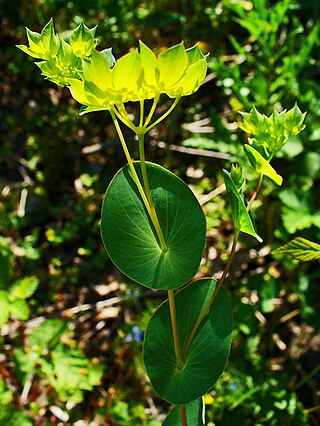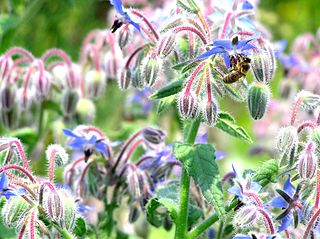
Artemisia is a large, diverse genus of plants belonging to the daisy family Asteraceae, with between 200 and 400 species. Common names for various species in the genus include mugwort, wormwood, and sagebrush.

Campanula is the type genus of the Campanulaceae family of flowering plants. Campanula are commonly known as bellflowers and take both their common and scientific names from the bell-shaped flowers — campanula is Latin for "little bell".

Adenophora is a genus of flowering plants in the family Campanulaceae, the bellflowers. Plants of this genus are known commonly as ladybells. Most are native to eastern Asia, with a few in Europe. Many are endemic to either China or Siberia.

Androsace, commonly known as rock jasmine, is a genus of flowering plants in the family Primulaceae, second only to Primula in the number of species. It is predominantly Arctic–alpine, with many species in the Himalayas, the mountains of central Asia, the Caucasus, and the southern and central European mountain systems, particularly the Alps and the Pyrenees.

Bupleurum is a large genus of annual or perennial herbs or woody shrubs, with about 190 species, belonging to the family Apiaceae. The full size of its species may vary between a few cm to up to 3 m high. Their compound umbels of small flowers are adorned with bracteoles that are sometimes large and may play a role in attracting pollinators. Rare among the Apiaceae are the simple leaves, bracts, and bracteoles. The genus is almost exclusively native in the Old World Northern Hemisphere, with one species native to North America and one species native to southern Africa.

Draba is a large genus of flowering plants in the family Brassicaceae, commonly known as whitlow-grasses.

Acriopsis, commonly known as chandelier orchids or 合萼兰属 is a genus of flowering plants in the family Orchidaceaes. Orchids in this genus are epiphytic herbs with spherical or cylindrical pseudobulbs, creeping, branched rhizomes, thin white roots, two or three leaves and many small flowers. The flowers are non-resupinate with the lateral sepals joined along their edges and have spreading petals and a three-lobed labellum. The column has projections that extend hood-like beyond the anther.

Boraginoideae is a subfamily of the plant family Boraginaceae s.s, with about 42 genera. That family is defined in a much broader sense in the Angiosperm Phylogeny Group (APG) system of classification for flowering plants. The APG has not specified any subfamilial structure within Boraginaceae s.l.

Pimpinella is a plant genus in the family Apiaceae; it includes the aromatic herb anise (P. anisum).

Seseli is a genus of herbaceous perennial plants in the family Apiaceae. They are sometimes woody at base with a conic taproot. Leaf blades are 1–3-pinnate or pinnately decompound. Umbels are compound, with bracts few or absent. Petals are white or yellow, and the fruit ovoid or ellipsoid.

Liparis liliifolia, known as the brown widelip orchid, lily-leaved twayblade, large twayblade, and mauve sleekwort, is a species of orchid native to eastern Canada and the eastern United States. It can be found in a variety of habitats, such as forests, shrublands, thickets, woodlands, and mountains. The orchid is considered globally secure, but it is considered rare or endangered in many northeastern states.

Subgenus Iris is one subgenus of Iris.
Cirsium kamtschaticum, the Kamchatka thistle, is an Alaskan and East Asian species of plants in the tribe Cardueae within the family Asteraceae. The species is found in eastern Russia, and on certain islands of the North Pacific: the Aleutian Islands of Alaska and Hokkaido Island in northern Japan.
Haplophyllum is a genus of flowering plants belonging to the family Rutaceae. It is the only genus in the subfamily Haplophylloideae.












